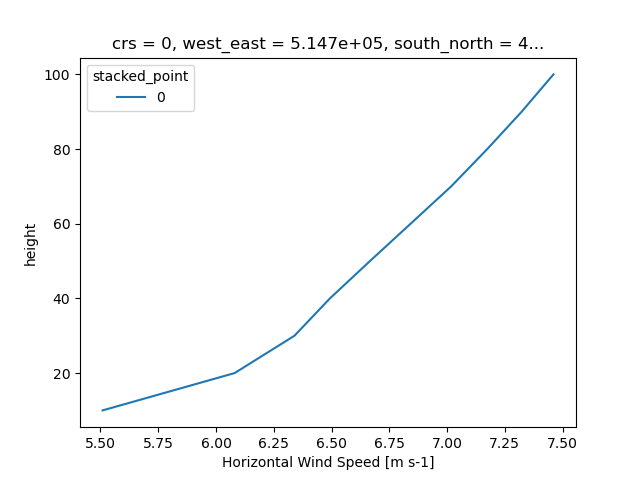Note
Go to the end to download the full example code.
Vertical extrapolation
Example of using PyWAsP to perform vertical extrapolation.
Prepare TopographyMap
First, we need to prepare the topography map. This is done by reading the elevation and roughness maps and creating a TopographyMap object.
Downloading SerraSantaLuzia.zip from Zenodo...
Downloaded SerraSantaLuzia.zip to /root/.local/share/windkit/tutorial_data/serra_santa_luzia/SerraSantaLuzia.zip
Define output locations
Second, we need to define the output locations. This is done by creating a dataset with the coordinates of the output locations.
output_locs = wk.spatial.create_dataset(
west_east=ssl.bwc.west_east.values,
south_north=ssl.bwc.south_north.values,
height=np.linspace(10.0, 100.0, 10),
crs="EPSG:32629",
struct="stacked_point",
)
print(output_locs)
<xarray.Dataset> Size: 177B
Dimensions: (height: 10, stacked_point: 1)
Coordinates:
* height (height) float64 80B 10.0 20.0 30.0 40.0 ... 80.0 90.0 100.0
south_north (stacked_point) float64 8B 4.621e+06
west_east (stacked_point) float64 8B 5.147e+05
crs int8 1B 0
Dimensions without coordinates: stacked_point
Data variables:
output (height, stacked_point) float64 80B 0.0 0.0 0.0 ... 0.0 0.0 0.0
Attributes:
Conventions: CF-1.8
history: 2025-07-22T14:10:25+00:00:\twindkit==1.0.3.dev1+ga612767\tw...
Calculate resource grid
Finally, we can calculate the resource grid. This is done by calling the predict_wwc function. This function takes the output locations, the boundary conditions, and the topography map as input. The output is a weibull wind climate dataset at the output locations.
wwc = pw.wasp.predict_wwc(ssl.bwc, topo_map, output_locs)
/builds/ram/software/pywasp/pywasp/modules/windkit/windkit/spatial/_bbox.py:263: UserWarning: 'use_bounds' currently defaults to False in BBox.reproject, in the future this will change to True
warnings.warn(
/builds/ram/software/pywasp/pywasp/modules/windkit/windkit/spatial/_bbox.py:263: UserWarning: 'use_bounds' currently defaults to False in BBox.reproject, in the future this will change to True
warnings.warn(
/builds/ram/software/pywasp/pywasp/modules/windkit/windkit/spatial/_bbox.py:263: UserWarning: 'use_bounds' currently defaults to False in BBox.reproject, in the future this will change to True
warnings.warn(
/builds/ram/software/pywasp/pywasp/modules/windkit/windkit/spatial/_bbox.py:263: UserWarning: 'use_bounds' currently defaults to False in BBox.reproject, in the future this will change to True
warnings.warn(
/builds/ram/software/pywasp/pywasp/modules/windkit/windkit/spatial/_bbox.py:263: UserWarning: 'use_bounds' currently defaults to False in BBox.reproject, in the future this will change to True
warnings.warn(
/builds/ram/software/pywasp/pywasp/modules/windkit/windkit/spatial/spatial.py:1087: UserWarning: Clipping bbox including marging is outside the bounds of the dataset to clip!
warnings.warn(
Plot the mean wind speed
We can plot the mean wind speed to see the result.
wwc["wspd"].plot.line(y="height")

[<matplotlib.lines.Line2D object at 0x704aa4496e90>]
Total running time of the script: (0 minutes 3.283 seconds)